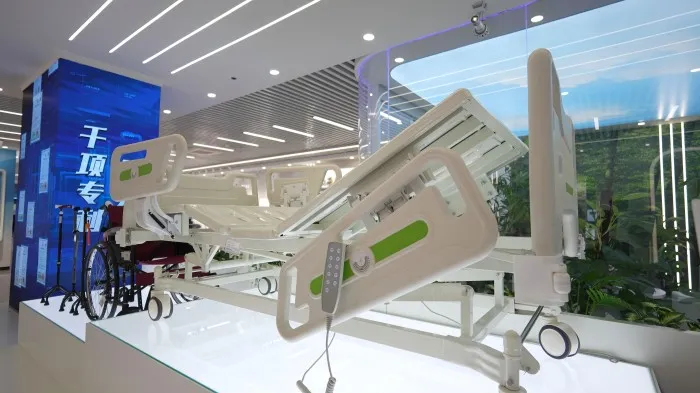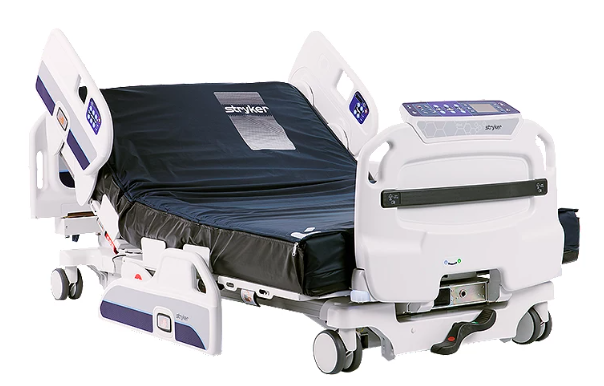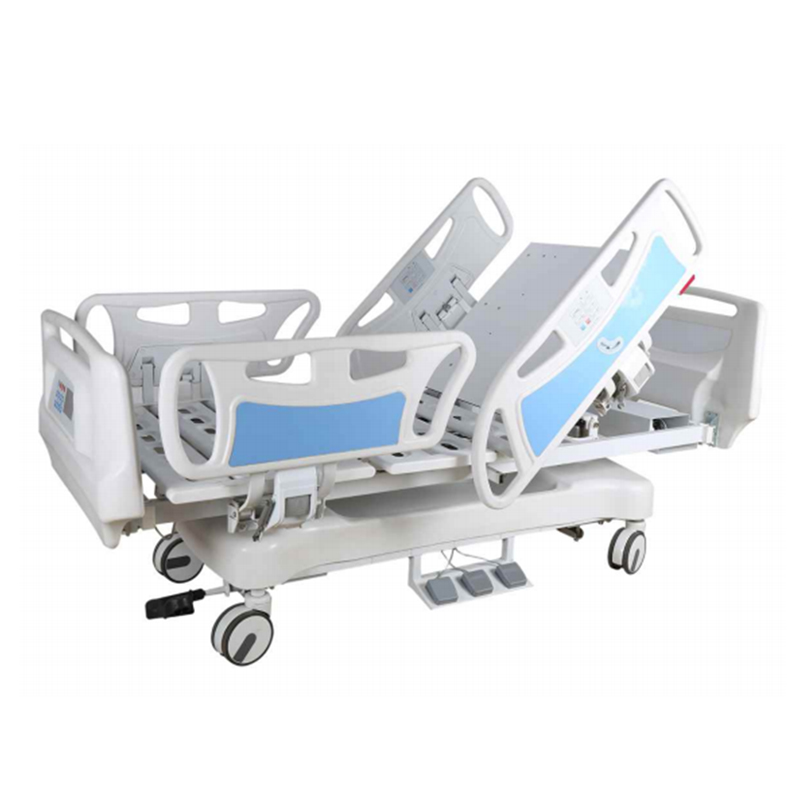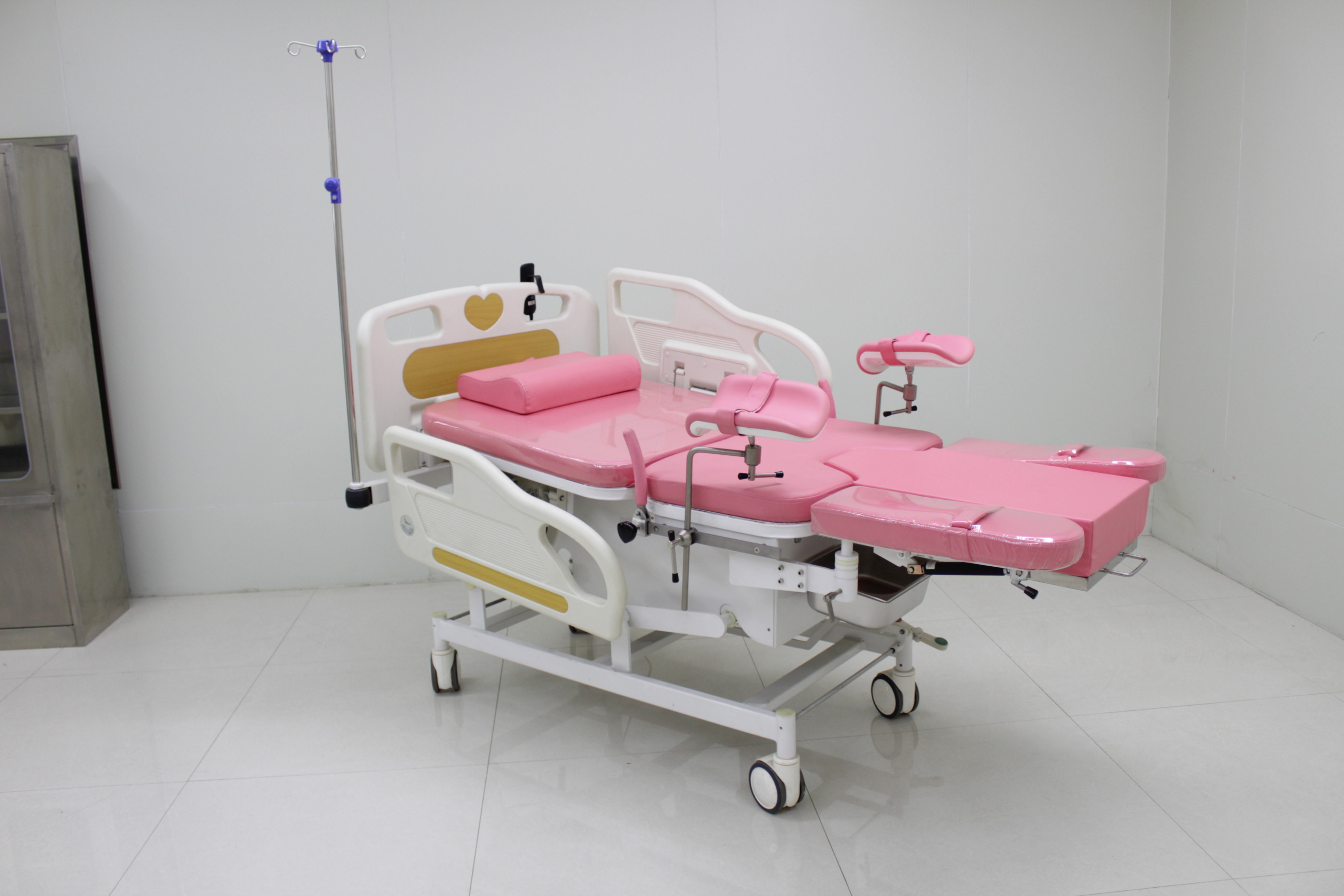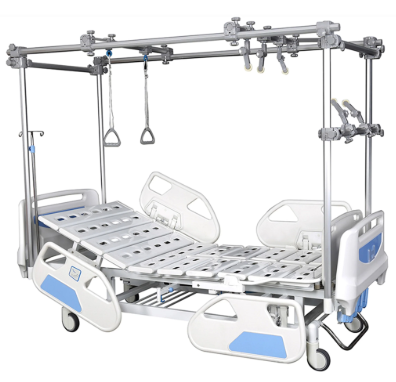There are many different types of Hospital beds.Choosing the right hospital bed can make a big difference in patient care. How do you choose the right one? Let’s look at the different types of hospital beds and why they matter.
| Category | Hospital Bed Type |
|---|---|
| According to Operation Mode | Manual Hospital Beds |
| Semi-Electric Hospital Beds | |
| Fully-Electric Hospital Beds | |
| According to Bed Function | Super Low Beds |
| Hi-Low Hospital Beds | |
| Bariatric Hospital Beds | |
| Pediatric Hospital Beds | |
| ICU Beds | |
| Birthing Beds | |
| Orthopedic Traction Beds |
Manual Hospital Beds
Manual hospital beds are a practical and cost-effective option for both home care and medical use. In my experience, these beds are simple but offer a lot of flexibility. Caregivers can adjust the headrest, knee section, and bed height using manual cranks or levers at the foot of the bed. This allows the bed to be easily adjusted to meet the patient’s specific needs. It’s like having control to adjust the bed with just a few smooth movements, ensuring the patient gets the right comfort at the right time.
Key Features of Manual Hospital Beds
- Adjustable Positions: Manual beds can be adjusted to multiple positions, such as head-up, foot-up, and full-fowler. This flexibility supports various patient needs, including mobility and circulation.
- Maneuverability: Manual beds have smooth-rolling, dual-locking casters that allow them to bear heavy loads while being easy to move through tight spaces like corridors or elevators.
- Sturdy Construction: The heavy-duty steel framework of manual beds ensures they are durable and can withstand frequent use.
Advantages of Manual Hospital Beds
- Cost-Effective: Compared to electric hospital beds, manual beds are more affordable, making them a great choice for those on a budget.
- Reliability: Due to their simple mechanical design, manual beds are highly reliable and require minimal maintenance. There are no electrical components to malfunction, adding to their durability.
- Suitability for Home Care: Manual beds are perfect for home care where the patient’s needs are simple and a caregiver is available to make the necessary adjustments.
Limitations of Manual Hospital Beds
- Physical Effort: Adjusting the bed requires physical effort from the caregiver, which can lead to strain, especially with frequent adjustments.
- Fewer Adjustment Options: Manual beds provide fewer adjustment options than electric beds, limiting adjustments to the head, knee, and height sections.
- Limited Functionality in Surgical Units: While manual beds work for pre-op and post-op care, they lack advanced features for some surgical procedures that require detailed positioning.
Semi-Electric Hospital Beds
Semi-electric hospital beds offer a great balance of convenience and affordability. With just a button, you can adjust the head and foot sections. You can also raise or lower the bed height manually with a simple hand crank. This design combines modern technology with practical features, making it easy for caregivers and patients to use.
Head and Foot Adjustment
- You can easily adjust the head and foot sections with the push of a button, allowing for a comfortable and supportive sleeping position.
- This feature also helps improve circulation, promoting better sleep and aiding recovery.
Manual Height Adjustment
- The bed height is adjusted manually using a hand crank, which requires some physical effort. This gives caregivers control over the bed’s elevation without needing electricity.
Useful in Power Outages
- Semi-electric beds come with a 9V battery backup, allowing the bed to be lowered during power outages. However, batteries are not included, so make sure you have a reliable power source.
Cost-Effective
- Semi-electric beds are usually more affordable than fully electric ones. The price typically ranges from $1,000 to $2,000, making them a great option for both hospital and home care.
Maintenance and Durability
- Semi-electric beds have fewer moving parts than fully electric beds, making them easier to maintain and reducing long-term maintenance costs.
- The sturdy frame construction ensures strength while keeping the bed light, and zinc-coated parts, like the spring deck, help prevent corrosion and increase the bed’s lifespan.
Fully-Electric Hospital Beds
“Fully-electric hospital beds provide great convenience and support. These beds can adjust to multiple positions with just the push of a button, ensuring comfort for both patients and caregivers. While they help reduce physical strain on caregivers, they depend on electricity and come at a higher cost compared to manual or semi-electric models. It’s important to weigh these factors carefully when considering their use in clinical or home care settings.”
———— Dr. John Smith , Senior Medical Equipment Specialist
Key Features of Fully-Electric Hospital Beds
- Electric Motor and Adjustability: These beds come with motorized controls for precise adjustments to the head, foot, and height. With the push of a button, users can change positions, including raising the head or foot, or adjusting the entire bed height.
- Control Mechanism: Patients and caregivers can control the bed using a handheld remote or controls built into the side rails. This removes the need for manual adjustments and makes handling the bed easier.
- Additional Positions: Some models offer special positions like the Trendelenburg position, where the legs are raised above the heart, and the Reverse Trendelenburg position, where the head is raised higher than the legs. These positions help improve blood circulation, aid breathing, and manage low blood pressure.
Benefits of Fully-Electric Hospital Beds
- Increased Independence: Patients can adjust the bed by themselves, which reduces their need for caregivers.
- Better Comfort: The ability to adjust the bed provides better support and comfort for patients.
- Increased Safety: Safety features like position locks stop the bed from moving into unsafe or uncomfortable positions.
- Easier for Caregivers: The automated adjustments reduce physical strain on caregivers, making it easier to take care of patients.
Suitable User Groups
- Elderly individuals
- People recovering from surgery or illness
- Those with mobility issues
- Patients who need the comfort of a hospital bed at home
Cost Range
Fully-electric hospital beds cost between $850 and $6,900, depending on the features and configurations.
Super Low Beds
Super low beds are a big help for people at high risk of falling, like the elderly, those with dementia, or anyone with limited mobility. I have seen how much of a difference these beds can make. They sit just inches off the ground, which gives me peace of mind. If someone were to slip, the fall would be less severe. It’s like a safety net, working quietly in the background. It provides not just security, but also a sense of comfort for caregivers and loved ones.
Height and Safety
Super low beds, also called ultra-low or floor beds, are very close to the ground, usually about 7.5 inches above it. This design minimizes the distance a patient could fall, which is especially important for those prone to accidents during sleep or movement.
Optimal Height for Safety
The height of these beds is key to patient safety. If the bed is too low, it can make it harder to get in and out of bed, raising the risk of falls. The right height lets patients sit on the edge with their feet flat on the floor, making it easier and safer to get up and down.
Additional Features
- Adjustable Height Settings: Many super low beds offer adjustable height options, letting caregivers raise the bed to a standard height for easier access.
Hi-Low Hospital Beds
Hi-low hospital beds offer comfort and convenience for both patients and caregivers. They come with adjustable height features that make it easier for patients to get in and out of bed. This is especially helpful for people with mobility challenges.
Adjustable Bed Height
One of the key benefits of Hi-low hospital beds is their ability to adjust to different heights. This makes it easier for patients to get in and out of bed with less strain and reduces the risk of falls.
Electronic Adjustment for Convenience
Hi-low hospital beds are electric, making height adjustments quick and easy. Patients or caregivers can adjust the bed with a remote control or pendant, without needing to use physical strength. This makes the bed safer and easier to use for both patients and caregivers.
Safety and Accessibility
Hi-low hospital beds are especially helpful for patients who use mobility aids like Wheelchairs or walkers. The bed can lower to a comfortable level, making it much easier for patients to transfer in and out of bed. This improves safety and accessibility.
Caregiver Assistance
The height adjustment feature is also helpful for caregivers. It allows them to assist patients or reposition them without putting too much strain on themselves. This is especially important when caregivers are short on time or don’t have the energy to adjust the bed manually.
Versatility and Comfort
Hi-low beds offer several position options, including adjustable head and foot sections. This allows patients to sit up comfortably for activities like eating or watching TV. The beds also support special positions, such as the Cardiac Chair, Trendelenburg, and Reverse Trendelenburg, to ensure comfort and proper posture for different needs.
Bariatric Hospital Beds
Bariatric Hospital Beds are designed for larger patients, providing more comfort and security than standard beds. They have spacious frames and higher weight capacities to offer extra support. This helps you feel safe and relaxed, even during tough times. It’s like having a solid base beneath you, supporting and comforting you when it’s needed the most.
Dimensions and Weight Capacity
- Widths: Bariatric beds come in widths of 42″, 48″, 54″, and 60″.
- Lengths: These beds usually measure between 80” and 88” in length, providing plenty of room for patients.
Weight Capacity
- The Drive 15300LW model supports up to 500 lbs and has a safe working load of 600 lbs.
- The Drive 15303LW model has a higher capacity, supporting up to 900 lbs and a safe working load of 1000 lbs.
Frame and Construction
- Bariatric beds are made from heavy-duty steel, which makes them strong and durable.
- Even though they are strong, these beds have a lightweight frame, making them easier to move and set up.
Adjustability Features
- These beds offer full electric adjustability for the head, feet, and frame height.
- The bed deck height can be adjusted from 13″ – 26″ with casters and 18″ – 26″ without casters, offering flexibility for patient care.
Bariatric hospital beds are crucial for giving specialized care to patients with higher weight requirements, ensuring both comfort and safety.
Pediatric Hospital Beds
Pediatric hospital beds are made with the needs of young patients in mind. They offer a safe, comforting space, helping children feel secure as they recover. It’s like a gentle hug that makes them feel cared for, even in a place that might seem scary.
Features of Pediatric Hospital Beds
- Designed for Children: Pediatric hospital beds are made to provide comfort and security during a child’s hospital stay.
- Adjustable Height: Many pediatric hospital beds allow caregivers to adjust the height for easier access. This makes caregiving and transfers simpler.
- Full-Length Side Rails: The beds have raised side rails to prevent falls and keep children safe while resting.
- Adjustable Head and Foot Positions: Some pediatric beds let you adjust the head and foot positions to help with various medical needs and improve comfort.
Types of Pediatric Hospital Beds
- Standard Pediatric Hospital Beds: These beds come with safety features like side rails, bed exit alarms, and locking mechanisms to prevent falls and ensure safety.
- ICU Pediatric Hospital Beds: ICU beds are for critically ill or injured children. They have advanced features like high-level monitoring, better support, and easy access for medical staff.
Size Specifications for Pediatric Hospital Beds
| Item | Length | Width | Height |
|---|---|---|---|
| Child Hospital Bed | 46.1 inches (1170 mm) | 35.4 inches (900 mm) | 25 inches (635 mm) |
| Pediatric Crib | 31.5 inches (800 mm) | 19.7 inches (500 mm) | 30 to 38.5 inches (760 to 1000 mm) |
ICU Beds
ICU beds are designed for intensive care units. They provide features that focus on patient comfort, safety, and monitoring. These beds are equipped with functions that help support patients in critical conditions.
Key Features and Specifications
- Adjustable Positions:
- ICU beds allow for electronic adjustments of the backrest, footrest, and height. Positions like Fowler, Vascular, and Cardiac allow for the best positioning of the patient.
- The One Touch Cardiac Chair Position allows patients to turn the bed into a chair with one button, which makes certain treatments more comfortable.
- Auto-contour and auto-regression systems ensure smooth backrest adjustments, improving patient comfort.
- Safety and Stability:
- Central Lockable Twin Castors with swivel castors and brakes ensure stability and easy movement, keeping the bed in place.
- Monitoring and Equipment Integration:
- feature integrated items like an oxygen tank holder, accessory outlets, and up to four IV sockets for easier access to medical equipment.
- The in-bed scale and electronic scale system let caregivers measure a patient’s weight without moving them, which is vital for intensive care.
- The bed also has an X-Ray cassette holder at the backrest and a linen holder for better organization of patient care items.
- Patient and Caregiver Controls:
- A handheld controller is available for both patients and nurses. It’s designed for comfort and ease of use.
- Features like backlit patient controls, caregiver pendant, and foot controls help caregivers adjust the bed settings.
- Point of Care Siderails Control lets caregivers operate both siderails using a touch screen, improving efficiency and patient care.
- Dimensions and Capacity:
- The bed typically measures 2130-2210 mm in length, 1050-1100 mm in width, and has a height range of 360-910 mm.
- The weight capacity of ICU beds generally supports up to 150 kg, accommodating a variety of patient needs.
These specialized features make ICU beds essential for delivering high-quality care in intensive medical environments.
Birthing Beds
Birthing beds are designed for use during labor and delivery. They have adjustable features to support both the mother and baby throughout the birth.
Electric Adjustments
- Birthing beds, like the Grace Medy Birthing Bed, offer electric adjustments for easy position changes. This helps mothers find comfortable positions during labor by adjusting the backrest and height.
Hygienic Materials
- Modern birthing beds use hygienic materials that are easy to clean. This lowers the risk of infection and keeps the bed hygienic throughout the delivery.
Adjustable Backrest and Seating
- The Grace Medy Birthing Bed has an adjustable backrest (-12/+70°) and seating (0/+20°). It also includes a quick manual Trendelenburg position for flexibility and comfort during labor.
Stirrups and Calf Supports
- The Grace Medy Birthing Bed comes with adjustable foot stirrups and calf supports, providing essential support for the mother during delivery.
Mobility and Safety
- Many birthing beds, like the Grace Medy Birthing Bed, are mobile and have double castors and a central braking system. This allows for easy repositioning and ensures safety during emergencies.
Orthopedic Traction Beds
Orthopedic traction beds are special hospital beds designed for patients undergoing orthopedic treatments, surgeries, and diagnosing bone, joint, muscle, ligament, and tendon disorders. These beds offer essential support and comfort to those recovering from orthopedic injuries or surgeries.
Key Features of Orthopedic Traction Beds
- Detachable Head/Footboard: The head and footboards detach easily with a secure locking system, giving flexibility for different patient needs.
- Manual CPR: The bed has an optional manual CPR feature on both sides, ensuring emergency support is within reach.
- Central Brake System: The bed has a brake system at all four corners, keeping it firmly in place when needed.
- Hand Remote Control: The bed comes with a hand remote for easy operation by caregivers or patients.
- Four Split Side Rails: The bed includes four side rails that can be lowered, improving access for both patients and staff.
- Leg and Hand Traction Frame: This frame is used to apply controlled traction to different parts of the body, aiding the healing process for fractures or musculoskeletal injuries.
After choosing the type of hospital bed, it is also crucial to choose a reliable hospital bed manufacturer. Grace Medy is a factory that specializes in the production of hospital beds. They also provide supporting hospital bedside tcabinets, hospital chairs, medical carts, Operating tables, operating lights,and other supporting hospital furniture and rehabilitation equipment.If you need one-stop purchasing for hospital furniture, Grace Medy can save you a lot of effort.
Choosing a hospital bed is about more than comfort—it’s about improving the entire care experience. A manual bed may seem simple, but it has a charm in its straightforwardness. A fully electric bed, however, feels modern, offering features that meet every need with just a button press. The right bed can truly change a patient’s experience, making things more comfortable and accessible. Understanding the differences between these options is important—it’s like picking the right tool for the job. By choosing wisely, you’re not just ensuring comfort; you’re providing better care and, in the end, better health outcomes.



